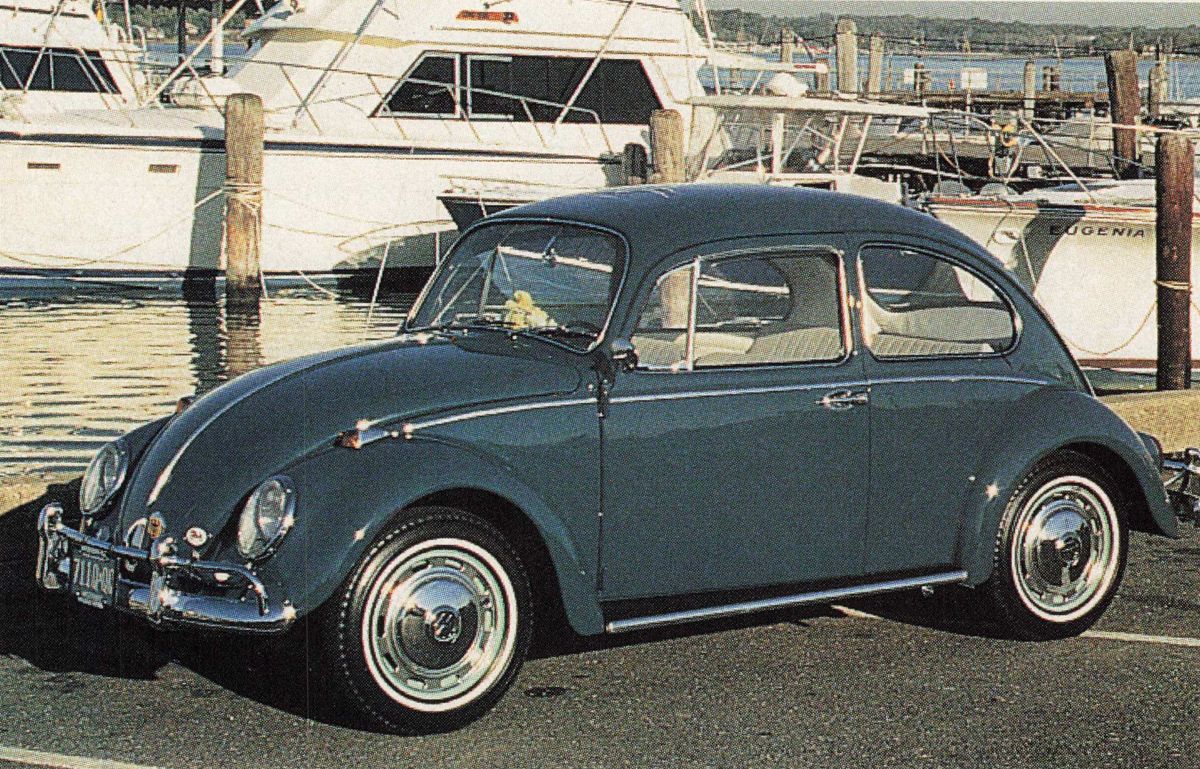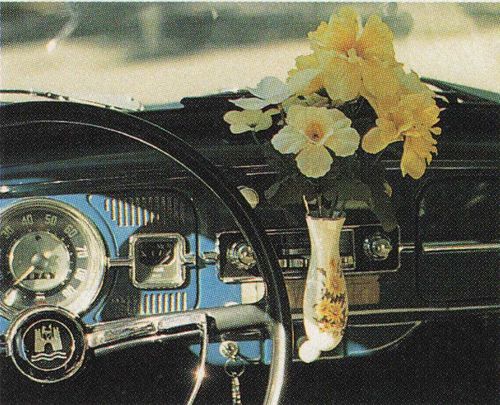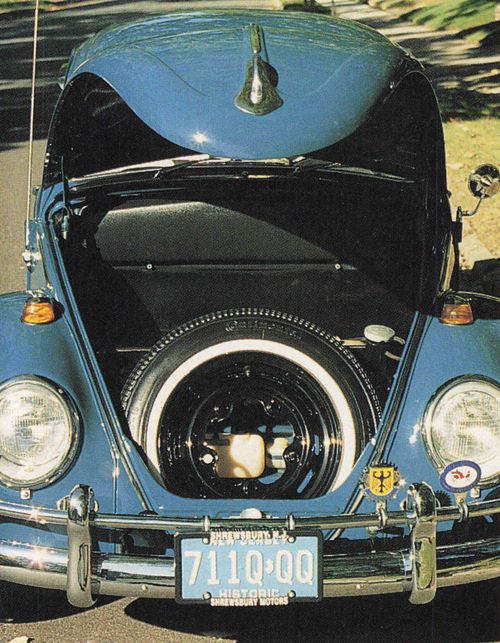1966 Volkswagen Beetle
Does the cost of buying and restoring an older car scare you? Maybe you should try Jack Bertini’s method: buy a new (or nearly new) car, and drive it for a few decades. That way, when is time for the restoration, you know exactly what’s original and have a good idea of what needs to be done.
It helps if you pick a car that’s affordable and so popular that millions were made and parts are readily available. But mostly, it helps if you love the car so much that you’ve devoted tender care to it since the day you brought it home.
What could inspire such a longterm affair? For Bertini, it was a blue 66 Volkswagen 1300. He found his love on the used car lot of a Dodge dealer in 1967. Apparently the original owner was accustomed to driving large American cars, and the diminutive VW wasn't to her tastes.
Bertini, on the other hand, liked the car — a lot. He says he always kept it garaged and washed it every Sunday.
The Beetle saw regular service as a family car through 1985. Bertini, his wife and two kids were just the size family Ferdinand Porsche had in mind when he started sketching prototypes of a “people’s car” back in 1931. It wasn’t until Bertini’s car pool reached five adults, a pretty tight squeeze, that he finally retired his favorite car from active duty.

The Volkswagen sat for five years. In late 1990, Bertini decided he had a classic in his garage that was worth restoring. “I had a two-year break between my son’s graduation from college and my daughter starting,” he said. “That was my chance.”
Bertini was lucky to have a friend, Doug Lomet, with 40 years’ experience as a body man. With Lomet’s help, he replaced the rusty rocker panels, a common problem on aging beetles. The rest of the body was solid, not uncommon on Volkswagens because the rounded shape sheds water well. Lomet put on a new coat of Sea Blue paint and touched up the wheels with a close match for the original green.
Bertini says many people don’t believe the Sea Blue color is original. However, he bought a tube of touchup paint when he purchased the car in ’°67. He and Lomet matched the paint numbers from this tube when they mixed the new paint.
After the car was painted, Bertini and his son Ed disassembled and restored the undercarriage, upholstery and engine compartment. The little 1.3 liter (1285 cc) boxer engine had 80,000 miles on it and needed rebuilding too. Bertini turned this task over to a local Volkswagen expert, Tom Abrams of Same Old Brand in Neptune, New Jersey.
The original trim on the car was in good condition. Bertini ordered a few replacement chrome parts but wasn't satisfied with their quality. He searched for a good plater before choosing a local plating shop with lots of marine experience less than five minutes from Bertini’s house. Marine plating has to be high quality to with stand the rigors of a salty environment. This shop did a nice job rechroming the Beetle’s bumpers, mirrors and ashtray; better than the replacements that he had originally ordered.
Many other parts of the car are original, even including the light bulbs and fuses. When replacements were necessary, Bertini ordered exact reproductions. Rocky Mountain Motorworks in Woodland Park, Colorado, supplied upholstery, headliner, rubber parts, carpets, hubcaps and beauty rings.
Since completing the bulk of the restoration in 1993, he has continued to find little items to fix. The chrome on one plastic radio knob was wearing thin. Reproduction knobs weren't quite like the originals, so Bertini started looking for a good original. After two years and countless trips to junkyards, he finally met a vendor at a swap meet who traded him a per fect knob for his used one plus $5.
Tires are the big quest now. Bertini had replaced the four road tires while he was regularly driving the car, but left the stock Continental spare under the hood. That combination is no longer good enough.
“I’m friends with a car show judge,” he says. “I told him to pick my car apart because I want to go to the (Antique Auto Club of America) grand nationals. He told me to get rid of the tires; all five have to match.”
Now Bertini is on the lookout for a set of four original Continental tires for the car. They won’t be easy to find, and he knows they won’t be cheap. Still, “I want that car original, and I’ve got to pay the price.” Unfortunately, he has no way of even estimating what this will cost him, because he’s dealing with a very rare commodity.
Recently, he asked his son Ed to watch for a set during a trip to California. Bertini is also writing to Germany looking for the Continental tires. “That’s the only thing on it that’s not original. That’s my craziness — I’ve got to get those tires.”

This level of fanaticism has its reward. Bertini remembers his first car show, where the Beetle took first place in its class against a field of Mercedes, BMWs, Panteras and MGs. In 1995, Bertini and his Beetle were invited to a prestigious indoor car show where most of the vehicles were mounted on stands with mirrors under them.
Pretty impressive stuff for a Volkswagen. “I take pride in it,” Bertini says. “I’ve been like that since age 16, I’ve always kept my cars clean and stuff. Now I’ve gone beyond that. It’s original.”
And, he adds, “It’s an obsession.”
Driving experience 1966 Volkswagen Beetle
Climbing into Jack Bertini’s pristine Beetle, I'm immediately impressed by the car’s simple elegance — the chrome accents and practical gauges, the gracefully sculpted controls, the blue paint and the perforated texture of the white seats all work well together. Some yellow flowers in a vase on the dash lend a nice vintage touch. the vase is an original VW accessory, though this one is a reproduction from Rocky Mountain Motorworks. Originals go for $300.

The controls also have an antique feel, mostly because of the large, skinny steering wheel and spindly gear shift with a knob on top. The gauges are minimal, just a speedometer and gas gauge, but they are large and easy to read, and idiot lights for oil and the generator give you the rest of the information you readily need. [here are just a few plastic knobs on the dash, one for the lights, a wiper/washer knob above the radio, a four-way flasher knob, which was new for 66, and an ashtray knob. The interior recalls the simplicity and good taste of a ’30s automobile so well that the transistorized radio seems jarringly out of place. Sitting behind the wheel, | notice the car seems tall even though it doesn't stand any taller than most new Volkswagens. Perhaps this perception comes from the combination of ample headroom, (Um slightly over six-feet tall, yet there are still a few inches between my head and the roof.) seat construction which encourages a very upright driving position, and the window sills which are higher than on modern cars. In front, the hood drops away sharply and adds to the sensation of height. Height is the one dimension where the car is generously endowed. I’m elbow-to-elbow with Bertini in front, and the back seat looks like a cozy cubby-hole for small kids. It’s a snug feeling, but thanks to the headroom it not overly cramped or claustrophobic. Turning the key brings a familiar ruckus to life. The VW’s engine note is one of the most identifiable sounds in the automobile world, right up there with the chug of a Model A Ford, and the rumble of a big-block V-8. Ninety-nine out of 100 blindfolded people could identify it by sound only on a New York street corner.
At idle, the flat four Spins at 850 rpm, and you feel you almost can hear each cylinder firing individually. There’s a hint of valve noise, common to air-cooled engines. Under load the cooling fan adds a slight whistle and the chug becomes a low, rasping buzz. Its not intrusive while driving, and to any certified VW car nut it’s like a favorite oldie played on the radio.
Ive driven several Volkswagens, and they always surprise me. The little engine has plenty of torque and is aided by good gearing that lets you rev through the engine’s rpm range quickly. It’s almost a sports car feel, and it’s definitely fun.
The shifter seems tall and extremely vague, but this impression is unfounded. Although you can't feel any gate guiding you from gear to gear, you guess the approximate direction for the next shift, move the lever a long way, and somehow never miss a shift. The synchro is great, lending a touch of butter to every gear change. The clutch and brake pedals Nave a rubbery feel to them, rather like stepping on an inner tube.
Handling is really pretty tight as the Beetle responds quickly to light Steering inputs. But it leans in corners and, with its short 94.5-inch wheelbase, it tends to get bouncy over bumps.
There is much about this car that feels like plastic and rubber as opposed to the all-steel, heavy feeling of its American contemporaries, but it’s not a cheap feeling. Rather, I get the impression that this is an economy car built with light, low-cost materials to a high-quality standard. The simplicity is attractive, and the cars eagerness for driver involvement makes every trip a treat.
Expert Tips on Restoring a Beetle
Volkswagen Beetles make affordable and easy first-restoration projects. Jim Siegfried, president of the Vintage Volkswagen Club of America, recommends that would be collectors look for a good, clean car from the Southwest or even the central states. He estimates that 1967 and older VWs are worth $4000 to $5000 in complete and accurate original condition, meaning no aftermarket sheetmetal or modified motors. | Convertibles are worth as much as 50 percent more, while sunroofs add 15 percent to 25 percent.

A typical restoration candidate, meanwhile, will cost $500 to $1000 dollars. “Figure you'll put three times that into it to” replace the rotted steel,” he warns, (assuming that you'll pay to have a body shop replace the metal rather than do it yourself). Rust is mostly found in rockers and floors, and sometimes in frame heads - and door pillars. The rest of the body usually is good. the split-window Volkswagens built before 1952 ate popular, but Siegfried says parts for those models are rare and expensive. An NOS taillight for a 50 bug, for in stance, will cost you $400. He considers the 53-57 models with oval rear windows the most desirable because of their rarity and “classic” looks, but also likes the ’66 and ’67 Beetles because their bigger engines made them better drivers. He notes 66 Beetles had the last of the classic bumpers and fenders with glass headlight covers and, further more, 66 was the only — Beetle to carry the 1300 (1285 cc) engine in America. In 67 Volkswagen changed its design to meet federal safety standards and moved up to a 1500 (1493 cc) engine and a 12-volt electrical system.
One advantage for driver/restorer types is that three-point seatbelts are a correct option. Siegfried says that although the °62-'66 models didn’t have standard-equipment belts, they came with attachment points installed and factory bulletins explained how to retrofit 61 and older mod els, so the VW cub doesn’t deduct judging points for these.
When shopping for a car, Siegfried warns that the two most common problems are rust and missing parts. Rust in the rocker panels can sometimes be detected early since the rockers double as heating ducts. Poor heater air flow can signal a problem here.. “The heater channels are horrible to replace,” Siegtried says. He also warns that if the frame heads (where the front suspension attaches) are rusty, the car is a project for experts only.
As for missing pieces, he says “If you have missing interior or body parts, like taillights, you’re going to spend a bunch of bucks to replace them.” For example, an NOS taillight assembly for a ’66 bug runs $50, an interior kit costs $250. and the older and rarer the beetle, the higher these prices go.
Mechanically, VWs are reliable and dead simple to work on the mechanicals. Siegfried says the transmissions are nearly bulletproof and engines should be good for 100,000 miles with proper care. He suggests checking compression and valve clearances on any car you consider buying.
~The valves on Volkswagens should be checked every 2000 miles, as air cooling places a lot of stress on them. Many owners tended to overlook this, and Siegfried notes that rusty bolts holding down the valve covers are a sign of serious neglect.
Parts for Beetles are widely available and often less expensive than for Other antique cars.
Siegfried prefers German-made parts available through several major parts suppliers. Volkswagen dealers can also supply items if you know the correct part numbers. The cheaper and more common Brazilian-made parts vary in quality; mechanical parts are okay, but Siegfried doesn’t recommend Brazilian sheetmetal or any parts from Taiwan.
















